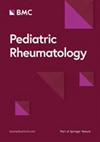幼年特发性关节炎患儿的血脑屏障通透性和星形胶质细胞源性细胞外囊泡:一项横断面研究
IF 2.8
3区 医学
Q1 PEDIATRICS
引用次数: 0
摘要
幼年特发性关节炎(JIA)是儿童中最常见的风湿性疾病,炎症过程被广泛研究,其主要特点是对关节健康的影响。新的证据表明,JIA 还可能影响中枢神经系统(CNS)。本研究通过分析血浆中星形胶质细胞衍生的细胞外囊泡 (EV) 和 S100B 蛋白的存在情况,研究了 JIA 可能对中枢神经系统造成的影响,这两种物质都是星形胶质细胞活性和血脑屏障 (BBB) 完整性的指标。通过流式细胞仪测量法分析了90名确诊为JIA的儿童和10名健康对照者的乙二胺四乙酸(EDTA)血浆中的细胞外囊泡。用流式细胞仪识别了来源于星形胶质细胞的EV,其标记为水汽素4(AQP-4)和胶质纤维酸性蛋白(GFAP)。S100B 蛋白的水平用商业 ELISA 进行测量。疾病活动度采用幼年关节炎疾病活动度评分(JADAS27,0-57)进行评估,疼痛程度采用视觉模拟量表(VAS,0-10 厘米)进行测量。我们的分析表明,与健康对照组相比,JIA患儿血浆中星形胶质细胞衍生的EVs浓度明显更高。此外,JADAS27评分为1或更高的患儿血浆中这些EVs的含量也明显更高。只有在JIA组中才能检测到S100B蛋白。JIA患儿中星形胶质细胞衍生的EVs水平升高和S100B的存在提供了BBB破坏和中枢神经系统受累的证据,尤其是在那些疾病活动性较高的患儿中。这些发现强调了在综合治疗 JIA 时考虑中枢神经系统健康的重要性。还需要进一步的研究来阐明中枢神经系统参与JIA的背后机制,并开发出既能治疗关节症状又能治疗中枢神经系统症状的治疗方法。本文章由计算机程序翻译,如有差异,请以英文原文为准。
Blood brain barrier permeability and astrocyte-derived extracellular vesicles in children with juvenile idiopathic arthritis: a cross-sectional study
Juvenile idiopathic arthritis (JIA) is the most prevalent rheumatic disease in children, and the inflammatory process is widely studied, primarily characterized by its impact on joint health. Emerging evidence suggests that JIA may also affect the central nervous system (CNS). This study investigates the potential CNS involvement in JIA by analyzing the presence of astrocyte-derived extracellular vesicles (EVs) and the S100B protein in plasma, both of which are indicative of astrocyte activity and blood-brain barrier (BBB) integrity. EDTA plasma from 90 children diagnosed with JIA and 10 healthy controls, matched by age and gender, was analyzed for extracellular vesicles by flow cytometric measurement. Astrocyte-derived EVs were identified using flow cytometry with markers for aquaporin 4 (AQP-4) and glial fibrillary acidic protein (GFAP). Levels of the S100B protein were measured using a commercial ELISA. Disease activity was assessed using the Juvenile Arthritis Disease Activity Score (JADAS27, 0–57), and pain levels were measured using a visual analogue scale (VAS, 0–10 cm). Our analyses revealed a significantly higher concentration of astrocyte-derived EVs in the plasma of children with JIA compared with healthy controls. Furthermore, children with JADAS27 scores of 1 or higher exhibited notably higher levels of these EVs. The S100B protein was detectable exclusively in the JIA group. The elevated levels of astrocyte-derived EVs and the presence of S100B in children with JIA provide evidence of BBB disruption and CNS involvement, particularly in those with higher disease activity. These findings underscore the importance of considering CNS health in the comprehensive management of JIA. Further research is required to elucidate the mechanisms behind CNS engagement in JIA and to develop treatments that address both joint and CNS manifestations of the disease.
求助全文
通过发布文献求助,成功后即可免费获取论文全文。
去求助
来源期刊

Pediatric Rheumatology
PEDIATRICS-RHEUMATOLOGY
CiteScore
4.10
自引率
8.00%
发文量
95
审稿时长
>12 weeks
期刊介绍:
Pediatric Rheumatology is an open access, peer-reviewed, online journal encompassing all aspects of clinical and basic research related to pediatric rheumatology and allied subjects.
The journal’s scope of diseases and syndromes include musculoskeletal pain syndromes, rheumatic fever and post-streptococcal syndromes, juvenile idiopathic arthritis, systemic lupus erythematosus, juvenile dermatomyositis, local and systemic scleroderma, Kawasaki disease, Henoch-Schonlein purpura and other vasculitides, sarcoidosis, inherited musculoskeletal syndromes, autoinflammatory syndromes, and others.
 求助内容:
求助内容: 应助结果提醒方式:
应助结果提醒方式:


